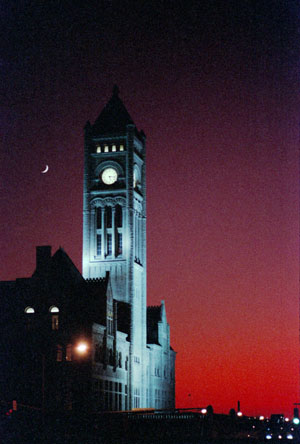 For this week’s Monday color, we hearken back (not to be confused with harkening back) to 1991 I believe, during a training seminar for animal cruelty investigation being held in Nashville, Tennessee. I had some free time in the evening and was wandering around the downtown area when the sky was suffused with some very rich hues at sunset. Spotting the crescent moon in the sky, I quickly lined up a shot with the Union Station clock tower, braced against a light pole, and snapped the shot.
For this week’s Monday color, we hearken back (not to be confused with harkening back) to 1991 I believe, during a training seminar for animal cruelty investigation being held in Nashville, Tennessee. I had some free time in the evening and was wandering around the downtown area when the sky was suffused with some very rich hues at sunset. Spotting the crescent moon in the sky, I quickly lined up a shot with the Union Station clock tower, braced against a light pole, and snapped the shot.
Only, this is an approximation of what it looked like. All films (remember, 1991) have their own color registers, not really true neutral, and so will often produce a faint color cast. This can become even more pronounced for long exposures, when the different layers of the emulsion responsible for each color have a different sensitivity to low light levels. I had just purchased this film – Kodak 1600 if I remember right – specifically to do night photos, and when the magnificent deep red sky turned to indigo, there was no way I could pass it up.
When seeing the prints, however, they were not at all how I remembered the sky – since it was only a week or so later, we’re not talking distant memories. Thinking that the lab had introduced a color shift during printing, I later took the same negative to a make-your-own-print machine and tried my luck there, getting largely the same results. Many years later, I was able to scan the negative directly with a film scanner, and fully confirmed that no, the film simply had not registered virtually any of the blue in the sky at all.
 In fact, it looked like this, and even at this reduced size, you can also make out just how grainy it is. The detail is actually pretty impressive when seen at higher magnification, but the color rendition of the sky was ridiculously far off (and convinced me to avoid that film forever thereafter.) As I learned some photo editing skills, I dug out the original negative and rendered the sky the way that I remembered it, making sure I didn’t alter the registers anywhere else, since the rest of the image seemed perfectly appropriate.
In fact, it looked like this, and even at this reduced size, you can also make out just how grainy it is. The detail is actually pretty impressive when seen at higher magnification, but the color rendition of the sky was ridiculously far off (and convinced me to avoid that film forever thereafter.) As I learned some photo editing skills, I dug out the original negative and rendered the sky the way that I remembered it, making sure I didn’t alter the registers anywhere else, since the rest of the image seemed perfectly appropriate.
I have to note that this image has more than enough information to actually pin down the day it was taken. The shooting angle can easily be determined from the building façade, and the height and phase of the moon, tied in with the time showing on the clock, are enough to narrow the possibilities down to only two days that year, at least. While a waxing crescent moon occurs every 29 days, it can only occur in that position at that point in twilight twice per year; any other days will see the sun setting later or earlier. Chances are pretty good that the weather conditions wouldn’t be exactly the same for both possible days, and it might even be true that the moon would be in a different latitude. A lot of people don’t realize how specific orbital mechanics can be.
Also, remember this situation for when you run into philosophers, so you can ask them if the edited photo now represents a true- or false-color image. They’ll go on about what’s ‘true’ from the emulsion’s point of view and the subjectivity of experience and probably make up a few brand new terms – you’ll keep them busy for hours…




















































